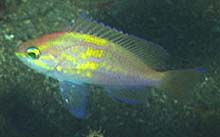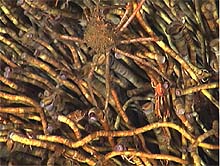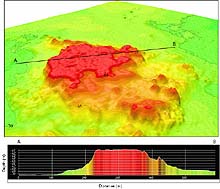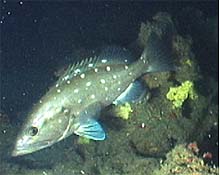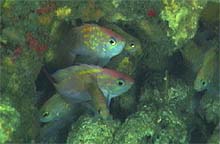
Note the difference in the eye size (white arrows) of the pelagic species Systellaspis (above) that lives between 500-700 m depth, and Glyphocrangon (below) that lives between 700-1500 m depth. Click image for larger view.
Pinnacles Profile
Description
Along the edge of the continental shelf from the Missippi River Delta to the DeSoto Canyon, southeast of the Florida/Alabama border, a broad band of "drowned reefs" or "fossil reefs" occur from water depths of approximately 70 m to over 120 m (230 to 400 ft). In the 1930’s scientists discovered reef-like structures in the northwestern Gulf off Texas and Louisiana that they called "pinnacles" due to their tall, steep-sided shape.
In the 1950’s, geologists also discovered a band of similar reef structures south of Mississippi and Alabama, an area now generally known as "The Pinnacles". Pinnacles reefs are currently too deep for reef-building corals to grow, and scientists suggested that these reefs were formed during low sea levels associated with the last ice age. Due to the occurrence of valuable oil and gas resources in this region of the Gulf of Mexico, government agencies have sponsored extensive research programs to study the geology, biology and oceanography of these shelf-edge reef communities.
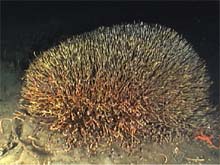
Tube worm colonies are associated with hydrocarbon and brine seeps in deepwater areas of the Gulf of Mexico, and occur in the deeper waters surrouding the Pinnacles. These images were taken by Dr. Sylvia Earle at 1800’ during the Islands in the Stream expedition. Click images for a larger view.
The Pinnacles area (left) in the northeastern Gulf of Mexico, and Yellowtail Reef (right), the study site visited during the Sustainable Seas Expedition during June 2001. Depth contours on the Yellowtail Reef map are in meters. Click images for a larger view.
While no reef-building corals currently exist on reefs at the Pinnacles, invertebrate communities are considered to be of tropical Atlantic origin and are dominated by soft corals, sponges, crinoids, black corals and small, solitary hard corals. Reef fish communities include a number of species that are not found on shallow coral reefs, including the roughtongue bass and red barbier, the most abundant species on reefs in this region. Large predatory species that are commonly found here include groupers such as scamp and snowy grouper, red snapper, and amberjack. In deeper areas to the west and south of the Pinnacles, hydrocarbon and brine seeps support chemosynthetic communities that include tube worms and mussels.
Maps
Images, additional maps and more information about Pinnacles reefs are available.
Protected Areas
There are no Marine Protected Areas in the Pinnacles region.
Habitats at the Pinnacles
- Deep rocky reefs
- Patch reefs
- Drowned reefs
- Pinnacles
- Hard bottom
- Algal sponge communities
- Brine seeps/flows
- Chemosynthetic communities
- Fault scarps
Key Species
| Roughtongue Bass | Pronotogrammus martinicensis |
| Red Barbier | Hemanthias vivanus |
| Spanish Flag | Gonioplectrus hispanus |
| Red Snapper | Lutjanus campechanus |
| Vermilion Snapper | Rhomboplites aurorubens |
| Scamp | Mycteroperca phenax |
| Snowy Grouper | Epinephelus niveatus |
| Black Corals | Antipatharians |
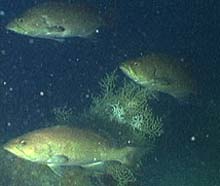
Deepwater reef communities form important feeding and spawning habitat for large predators such as scamp grouper (left) and snowy grouper (right). Click images for a larger view.
Interesting Facts about the Pinnacles
- The Pinnacles are located in a region of oil and gas resources, and production platforms are located throughout the western half of the study area. Additional lease sites of planned oil and gas drilling are located in this region of the Gulf of Mexico.
- The Pinnacles are part of a shelf-edge reef complex throughout the Gulf of Mexico and southeastern United States that is considered to be critical spawning habitat for many commercially important species of groupers and snappers, and are home to many species that do not occur on shallow coral reefs such as the Spanish flag and roughtongue bass.
- Due to the great water depths at the Pinnacles, plant growth is extremely limited, reducing the availability of food to many fish species. Herbivorous (plant-eating) grazers such as parrotfishes (family Scaridae) and surgeonfishes (family Acanthuridae) are absent from these reef communities, and plankton is the most common food resource for fishes and suspension-feeding invertebrates.
- The Pinnacles are considered to be remnants of "paleoshorelines" when the majority of the continental shelf was exposed to air during lower sea levels associated with the last ice age, approximately 18,000 years ago.
- Individual Pinnacles reefs were probably formed between 10,000 and 18,000 years ago when sea levels were 66-120 m (223-395 feet) lower than present levels. Reef-building communities could not keep up with the rising seas, which reached current levels about 7,000 years ago, leading to the formation of the "drowned" reef communities that are present at the Pinnacles today.
Sign up for the Ocean Explorer E-mail Update List.












































